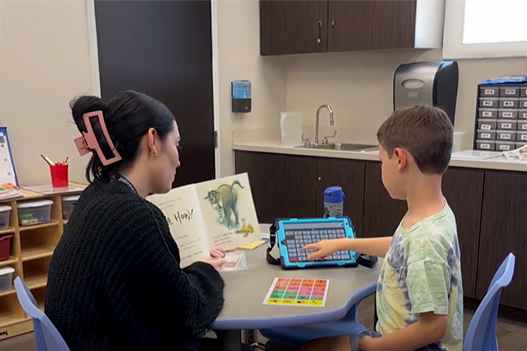Key Points:
- Speech-language pathologists work to enhance communication and independence in autistic individuals through the use of Augmentative and Alternative Communication (AAC) AAC tools.
- Challenges to using AAC include lack of knowledge, negative attitudes, financial and time constraints, and use of systems that are not customized to the needs of the AAC user, all of which serve to limit communication and engagement.
- Training communication partners and advocating for better resources, funding, and customized communication systems are essential for improving access and supporting AAC users’ communication competence.
In recent years, numerous professionals working in the autism and special education fields have launched small businesses, using the materials they have crafted, drinkware for personal use, and other wearable accessories. It’s likely you’ll see professionals from all different disciplines wearing t-shirts with fun, catchy expressions or inspiring phrases like “communication looks different for everyone” or “your words matter.” How are we honoring those messages?

Engaged in the story, this boy uses his communication device to answer question s and share his thoughts, bringing the tale to life with his comments.
Imagine struggling to express your thoughts and needs every day, unable to rely on spoken words to connect with those around you. For many individuals with autism, this is a reality, making communication a daily challenge that impacts their independence and well-being. Augmentative and Alternative Communication (AAC) offers a lifeline, but for AAC to be truly effective, the barriers to its implementation must be addressed.
As speech-language pathologists working with autistic individuals, we strive to provide an exceptional level of care and consideration for everyone’s overall well-being, which is largely dependent on effective communication development. Another important factor is fostering independence and ensuring the individuals we support can communicate effectively for all purposes daily. Often, the individuals we serve cannot rely solely on spoken language alone to meet all their communication needs. Professionals have seen the value of AAC as tools to support communication development for individuals who benefit from utilizing alternative communication modalities.
AAC is not solely for individuals who do not use spoken language. It’s a valuable tool for anyone who experiences challenges communicating their wants and needs independently in everyday situations. While AAC may not be inherently intuitive and can present challenges, systematic instruction has proven effective for individuals with autism and complex communication needs.
Barriers to AAC implementation can include various forms of social, physical, and environmental challenges. In a study conducted by Yau, Choo, Tan, Monson, and Bovell (2024), some common barriers include:
- Stakeholder knowledge: lack of AAC knowledge
- Stakeholder attitude and stigma: negative attitudes towards AAC use or implementation
- Resources: financial funds and time demands
- AAC user engagement: willingness to use AAC
- Device fit and features: lack of customization to meet the needs of the AAC user.
Authors reference “stakeholders” as parents/caregivers, educators, and clinicians supporting AAC users. For the purpose of the article, we will refer to these individuals as communication partners.
Upon review of the study and clinical observations made in our history of practice, these challenges in implementation outlined are commensurate with attitudes noted by those charged with supporting AAC users. To support AAC users, we must first look at supporting their communication partners. This starts by shifting the attitudes and enhancing knowledge surrounding AAC, which can be done through methodical training across communication partners. Communication Partner training is key in supporting AAC learners in developing and generalizing acquired skills. That said, it is important to recognize that there is a learning curve when implementing AAC, and therefore, individuals in need do not become proficient AAC users overnight. The goal of a speech-language pathologist when training a novice team is to foster a growth mindset and to encourage teams to presume potential (Zangari, 2020).
With a focus on the communication development of individuals with autism, particularly those with complex communication needs, we have advocated for priority access to personalized and reliable AAC systems. In our personal practice, we have collaborated with third-party companies to assist families in assessing insurance coverage for personal communication devices. On a broader scale, we continue to advocate for a greater emphasis on allocating funds to ensure access to AAC. Research has shown that parents often must prioritize their child’s other needs, which can limit the funds available to access adequate communication support, such as AAC (Yau et al., 2024).
To justify the need for AAC, data is vital to accompany requests for the technology and support needed. By analyzing the usage of AAC, such as tracking the number of communication opportunities provided, we can further assess any additional areas where support is needed and further develop a personalized treatment plan (Zangari, 2013). Suitable feature matching is also vital in the overall success of AAC use. Systematic trialing of varied communication supports (e.g., no tech, low tech, mid tech, and high tech AAC) creates a personal connection, enhancing motivation and overall engagement with the system. Greater customization fosters the development of an AAC system that accommodates the individual user’s preferences, ultimately enhancing their quality of life.
A common obstacle to AAC implementation that is highlighted throughout this discussion is a lack of knowledge and understanding among stakeholders, including parents, educators, and clinicians. Many people hold misconceptions about AAC, believing it is only for individuals with severe disabilities. By providing comprehensive training and education, we can dispel these myths and promote a more positive attitude towards Augmentative and Alternative Communication.
Furthermore, it’s crucial to advocate for increased funding and resources to support AAC access and training. Providing access to a personalized AAC system, working collaboratively to support communication partners, and monitoring skills are vital in developing the primary areas of communication competence in AAC. The concept of “presuming potential,” or assuming all individuals can benefit from direct services and support and, as a result, further develop skills, encourages a shift in mindset that the AAC user has acquired all skills to be a competent communicator. This shift supports the systematic development of AAC user skills.
Amanda Lopez, MS, CCC-SLP, and Victoria Giannone, MA, CCC-SLP, ASDCS, are Speech-Language Pathologists at the Els for Autism Foundation®.
References
Yau, S. H., Choo, K., Tan, J., Monson, O., & Bovell, S. (2024). Comparing and contrasting barriers in augmentative alternative communication use in nonspeaking autism and complex communication needs: Multi-stakeholder perspectives. Frontiers in Psychology, 15, 1385947. doi.org/10.3389/fpsyt.2024.1385947
Zangari, C (2013, August 22). 5 Things to Consider About Data Collection in AAC. PrAACtical AAC. praacticalaac.org/praactical/data-collection-for-the-beginning-aac-user-essential-things-to-measure-to-expedite-progress/
Zangari, C (2020, September 7). Supporting Young AAC Teams: 5 Considerations for Facilitating Growth. PrAACtical AAC. praacticalaac.org/praactical/supporting-young-aac-teams-5-considerations-for-facilitating-growth/







